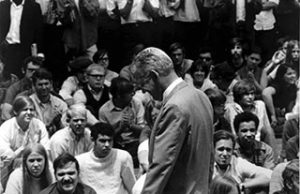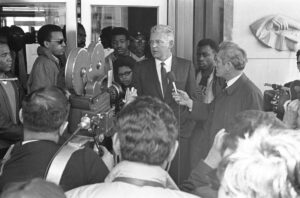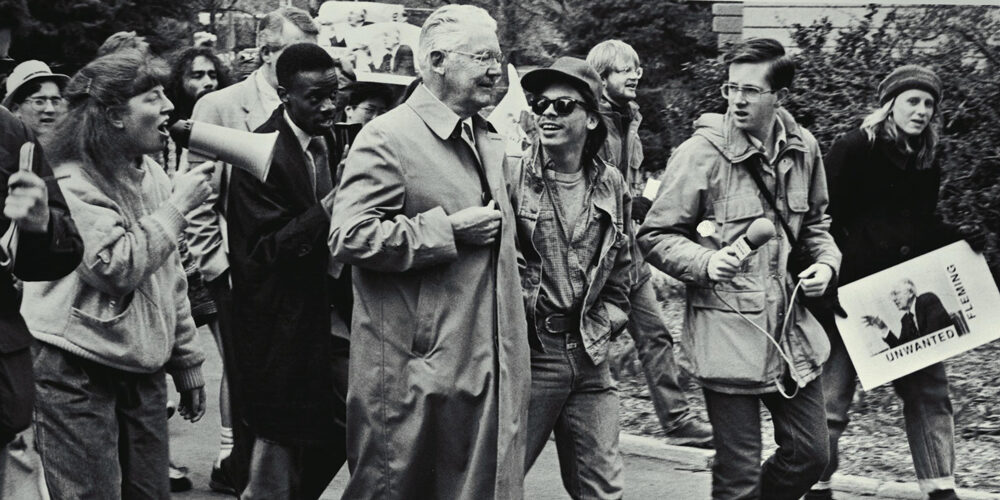The man who kept Michigan’s cool
When demolition crews brought down the Fleming Administration Building in 2022, students watching from a safe distance must have had only the foggiest image of the cool-headed president for whom the building was named.
Robben Wright Fleming (1916-2010) was president from 1968-78, some of the University’s most difficult years. He returned for a year as interim president in 1988.
Friendly, funny, and unpretentious, Fleming was steeped in the field of labor law. That was unusual training among university leaders; most rise through the mainstream academic disciplines. Yet his expertise in the mediation of labor-management disputes fitted him well for the challenges he faced. In Fleming’s era, major campuses from Berkeley to Columbia saw riots and violence. Under him, Michigan kept its cool.
In 1973, after the protest era had waned, Fleming said the most important development of his presidency to date had not been any particular event. Rather, “it is the fact that we have come through without a disaster.”
Conciliator-in-chief

President Robben W. Fleming at a student demonstration in 1969 (Image courtesy of U-M’s Bentley Historical Library.)
Born and raised in Paw Paw, Illinois, Fleming was educated at Beloit College, where he played varsity basketball, and the University of Wisconsin, where he earned his law degree at the start of World War II. He took a job with the War Labor Board, then joined the U.S. Army, serving in North Africa and Europe. After the war he went into labor relations, winding up as professor of law and director of a labor-law institute at the University of Illinois.
His rising renown as a mediator of workplace disputes led to his appointment as chancellor of the University of Wisconsin, where a conciliator was needed on a campus with rising student unrest. His skillful management there drew the attention of U-M’s regents when President Harlan H. Hatcher retired in 1967.
At his first press conference as president-designate, members of the leftist Students for a Democratic Society (SDS) shouted him down when he wouldn’t give yes-or-no answers to questions about police on campus. In his flat, midwestern tones, he said: “I don’t think you can have a great university without dissent. I will protect dissenters. In the case of demonstrations, I will interfere only to protect the University. I do not think that those who disagree with me are always wrong.”
Then he invited the protesters to meet with him the next morning at the Michigan Union. The discussion was lengthy and civil. He made it clear, again, that he would protect the right of dissent — but also that he would not tolerate a “heckler’s veto” of any speaker.
It wasn’t long before a leader of the Black Student Union said: “Fleming is this university’s biggest asset. He attempts to communicate with people. I never have the feeling I can’t go see him.”
A dove speaks out

U-M President Robben Fleming at Hill Auditorium, shortly before he came out against the war in Vietnam in September 1969. (Image courtesy of U-M’s Bentley Historical Library.)
Soon Fleming was dealing nearly every day with challenges arising from the faraway war in Vietnam.
He let it be known around campus that he opposed U.S. policy in Southeast Asia — not for the reasons cited by the New Left, who considered the U.S. a malevolent imperialist power, but because he thought good intentions had led to a tragic and costly blunder. When students asked him to say so in public, he decided he would. He thought moderate critics like himself should try to take the lead in calls for peace.
In the fall of 1969, on the Hill Auditorium stage — speaking only for himself, he said, not for the University — he called the U.S. war effort “a colossal mistake.” In the same speech, he authorized the use of campus facilities for a nationwide day of antiwar protest. (For his troubles, Vice President Spiro Agnew called him “gutless.” But Fleming had the last word. As he drily reflected in his memoir, “The vice president was not yet at the point where he was forced from office for accepting bribes, but he was immensely unpopular with both students and faculty and nothing could have helped me more than his remarks.”)
Elsewhere, university presidents feared that if they didn’t crack down at the first sign of dissent, protesters would be encouraged to escalate their actions. Fleming wasn’t so sure.
At one point, students in the Interfaith Council for Peace — hardly the most radical of the antiwar groups — proposed to dig a big hole in the Diag to symbolize the craters left by U.S. bombs in North Vietnam. Fleming said: “’Why not let them dig one? Everybody else is digging holes for new buildings. It’s not a big job to throw the dirt back in the hole after they get tired. If you make an issue of activities that do no harm and don’t interfere with the running of the University, you run the real risk of attracting a lot of other students who will then be sympathetic to their other demands.”
Fleming and the BAM strike

BAM demonstrators disrupt ceremony in Hill Auditorium as President Robben Fleming speaks, 1970. (Image courtesy of U-M’s Bentley Historical Library.)
In the spring of 1970, a new protest did threaten to interfere with the University’s business.
For months, students calling themselves the Black Action Movement (BAM) had pressed for a commitment to increase Black enrollment to 10% by 1973. The administration proposed to offer enough financial aid to make that possible, but would not promise to meet the 10% target on a timetable. So BAM called for a shutdown of all classes and set up picket lines.
For 12 days, attendance lagged while Fleming bargained with BAM. Most picketers peacefully encouraged students to stay home; others disrupted classes. Contrary to what the SDS had expected when he started, Fleming was trying, above all, to keep the police out of the strike, believing that a show of force could trigger violence. But he told BAM he would call in the cops if necessary to keep classes open for students who wanted to attend.
One administrator remembered a late night during the strike when BAM supporters were literally shouting at Fleming. His response was to say, again and again: “I hear you. What is your position?”
In the end, the strike was settled with the University’s promise to recruit more Black faculty, start a Black student center, and provide the funding for 10% Black enrollment — essentially what Fleming had agreed to before the strike.
U-M Regent Philip Power once remarked that Fleming saw clashes as the engine of progress. So he embraced them.
“I remember sitting in his office talking about some matter,” Power said, “and he turned to me and said, ‘Look, in all of history, all forward steps are accompanied by conflict. That’s the way it is; that’s the law of history. So let’s have some conflict!’ … His job was to figure out ways to use conflict to move things forward. And he was just extraordinarily skilled in that.”
Fleming himself said: “The typical academic administrator has never lived in a climate in which he was challenged in the way that a trade union challenges management. I was very frequently exposed to confrontations between companies and unions. I don’t take flights of rhetoric quite so seriously as some people do, and I don’t view showdowns as the end of the world.”
Reckoning with the women’s movement

During the turbulent ’60s and early ’70s, President Robben Fleming was a skilled diplomat when the University needed one. (Image courtesy of U-M’s Bentley Historical Library.)
Not that he embraced every change easily. When women faculty and staff members provoked a federal investigation of U-M for discrimination against women in hiring, pay, and promotions, Fleming fought back. Still, he proved to be open to persuasion.
At one point, several high-ranking U-M women asked him to consider a woman to be dean of the College of Literature, Science, and the Arts. He said it would be very difficult to find women ready for such a high post.
“For example,” he said, “when I brought Barbara Newell here from Wisconsin [as acting vice president for student affairs], you’ll see that every time Barbara had to make a critical decision, she hadn’t really had that experience before. I was there with her. I always backed her. I made a visible presence so that she had the support to go through it for the first time.”
Nellie Varner, U-M’s director of affirmative action and later a regent, said: “Mr. President, that’s all we’re asking of you; that you should treat women now the way you treated Barbara at the time; that if we don’t have the background, someone has to give us a leg up.”
Elizabeth Douvan, professor of psychology, was in the room. She saw Varner’s point register with Fleming.
“He thought about it,” she said, “and was much more positively oriented toward us on the way out than he had been on the way in.”
“A voice of reason and respect”
Mary Sue Coleman, president at the time of Fleming’s death, said: “Robben Fleming will be remembered in the same breath as Henry Tappan and James Angell as one of the truly great presidents of the University of Michigan. In an era of friction and fighting, he provided a voice of reason and respect. He served the University of Michigan with distinguished leadership, skill, integrity, and a grace that endeared him to a generation of students and faculty.”
With the Fleming Building gone, buildings at U-M that bear the names of past presidents now include Tappan Hall, Haven Hall, Angell Hall, Hutchins Hall, the Burton Memorial Tower, the Ruthven Administration Building, the Hatcher Library, the Shapiro Library, the Duderstadt Center, and Mary Sue Coleman Hall. (C.C. Little’s name was removed from the Science Building on East University in 2018.) That’s every president except Lee Bollinger, Mark Schlissel, and Fleming, whose name has been given to a conference room in the new Ruthven Administration Building.
Sources included: Robben W. Fleming, Tempests Into Rainbows: Managing Turbulence (1996);
Howard H. Peckham, edited and updated by Nicholas L. Steneck and Margaret H. Steneck, The Making of the University of Michigan, 1817-1992 (1967, 1994); William Haber and and Allan F. Smith, “The Fleming Years” in The University of Michigan: An Encyclopedic Survey; and James Tobin, “Me Too, Circa 1970,” University of Michigan Heritage Project; Day of Dissent,” Michigan Today, 6/3/2016; and “The BAM Strike” in Sing to the Colors: A Writer Explores Two Centuries at the University of Michigan (2021). Lead image of U-M President Robben Fleming surrounded by protesters during his interim presidency in 1988 comes courtesy of the Michigan Daily via the Bentley Historical Library.)




Barbara Stark-Nemon - BA 1971, MS 1979
Thank you for this informative and memory-invoking article. Robben Fleming was a gifted leader….. and also a great neighbor!
Reply
Thomas Richardson - J.D, 1982
Fleming was unfailingly polite. He was certainly the right man at the right time. He needs to have more than a conference room named in his honor. Keep publishing Jim Tobin. Excellent article, as usual.
Reply
James Tobin - 1978, 1986
Thanks, Tom!
Reply
Doris Rubenstein - 1971
Hi. I remember meeting you at the Oakland A’s game last May. I was at Michigan for the first three (exciting) years of Fleming’s administration. He truly was the right man for the times. I bumped into him years later on First Ave in NYC when I was en route to a Michigan alumni event; I invited him to join me, but he had a prior engagement. We had a couple of minutes to talk about those turbulent times before parting with “Go Blue” on both sides!
Reply
John Woodford
An interesting, informative and inspiring portrait. Someday, I hope, the late President James Duderstadt’s courageous, initially effective and sincere efforts to counter the effects of centuries of racism via the Michigan Mandate will receive similar recognition and appreciation. So far, neither local or national obituaries have done him credit. I think his initial successes stimulated reactionaries to use our retrograde Supreme Court faction to destroy affirmative action programs. DEI has proved to be a pale substitute, as it were, and thus an easy target.
Reply
David Burhenn - AB 1975, JD 1982
I agree with my Law School classmate Tom Richardson — another great James Tobin article. I have a theory that a great institution has to find the right leader for the times. Fleming was an inspired choice in an era of conflict, and a decent human being. And I also agree with Tom that Fleming deserves more than having a conference room named for him (not that having his name on that Alden Dow monstrosity was that great an honor).
Reply
John Lottier - 1968
My senior year, three of us Daily editors — Roger Rapoport, Steve Firschein and I — lived together in a ramshackle on Washtenaw. When Robben Fleming was named President, we invited him and his wife to join us for dinner there, and he graciously accepted.
Turned into three hours of lively and very funny conversation. He ducked no issues and was clearly ready to try his best at keeping Michigan on a strong, safe, even keel. His wife was terrific fun, even regaling us with the tale of how she nicknamed him Red Sails in the Sunset — it was his ears.
I wrote a column in The Daily on it — titled, if I recall — Trying Harder With President Fleming. I might have spilled some beans in the column, but Robben seemed to like it all the same. Now, I’m just happy to remember him, and that experience, now nearly 60 years ago.
Reply
Clifford Weiler - JD, December 1971
Robben Fleming taught a law school seminar, I think Public Sector Labor Law, maybe in 1970-1971. I had never taken a small seminar and had generally successfully avoided in undergrad and law school any class which required writing a paper. But I could not imagine a college president teaching anything to students, so I tried what turned out to be a life changing adventure with one of if not the best professor I ever had. The paper involved the then pending issue of if the faculty at U of M should unionize. Given the choice of pro or can, I naively chose the yes they should, expecting President Fleming would severely react to my arguments. As mentioned in the article and some comments, he reacted by listening and reacting fairly. As I now look back after retirement, having represented public school teachers and their union in Michigan and public school management and Boards in California, I now realize the great impact he had on me. Although as an advocate I represented my clients’ goals, listening and fairness were the cornerstones of his instruction which I carried throughout my career.
Reply
Ralph Johnson - 1971
Fleming was in charge in a low key way. We had blood poured in our ROTC files and later the old stone building was blown up.
But the University and the government stuck it out together. It was day to day fist fights.
The guy navigated a mine field. Nothing but admiration. We students got our education and midshipmen got our USN scholarships. And then finally the US got out of Viet Nam due to public pressure driven by students.
Fleming had a lot to do with that
Reply
Sonia Hulman - 1971; BS Chem
The Kent State shootings in May 1970 provoked a tremendous police presence on campus. However, there were no disruptions classes, activities and other university functions. Perhaps the author can describe President Fleming’s experience during this dreadful time in American domestic history (not as dreadful as the current time however).
Reply
Elaine Wangberg Menchaca, Ph.D. - 1970, 1979
President Fleming was, indeed, the best President for the time and, in my academic profession, for any time.
His willingness to listen and reason, his negotiating skills, his genuineness, and his leadership skills all led to
advancing the University and guiding it through revolutionary times successfully.
As a Professor, Dean and Vice President for Research, I drew on his leadership and the excellence of the University and was thankful. There definitely should be a building named after him.
Reply
William Lasher - 1974
I was a doctoral student at the U of M from 1968 to 1974. And I worked in the Office of Institutional Research from 1970 to 1974. Robben Fleming was President while I was a student/administrator. I never saw such a mild-mannered man who never got frustrated during the many confrontations with which he dealt. He was the model for university presidents at the time– and I think, for all times. (Conciliator-in-Chief is a grand title.) When I received my doctorate in August 1974, Dr. Fleming went out of his way to thank me for my work at the University. Robben Fleming knew a lot of people at the University– even one who remembers his special comments given at my graduation. I really appreciate your work, James Tobin. Thank you.
Reply
Sol Bermann
Still an exemplar in terms of steering an institution (*any* institution) forward through challenging times. The “Conciliator-in-Chief,” who didn’t avoid conflect, but rather addressed it head-on by listening with a keen sense of fairness, honesty, and integrity. Pres. Fleming deserves a building again, not just a conference room.
Reply